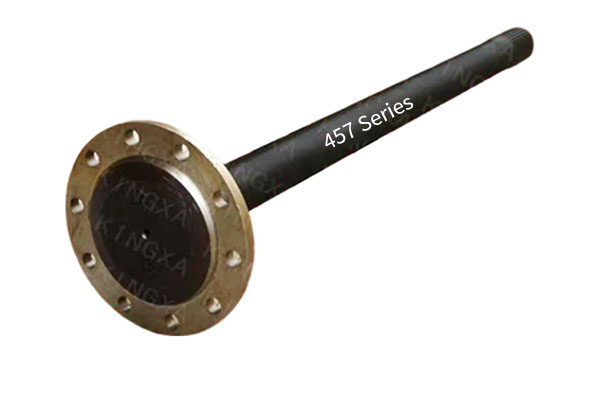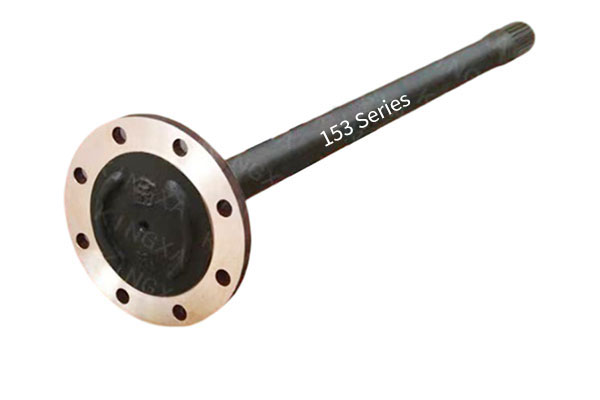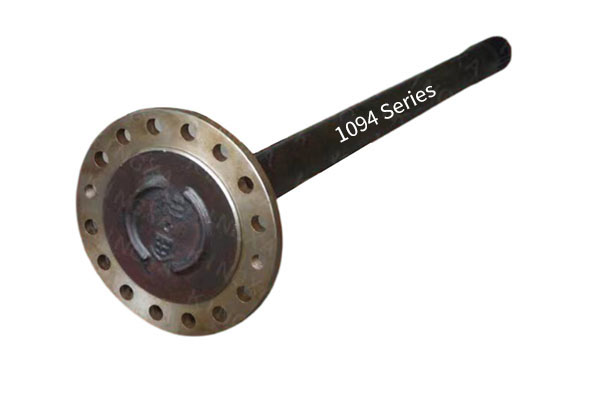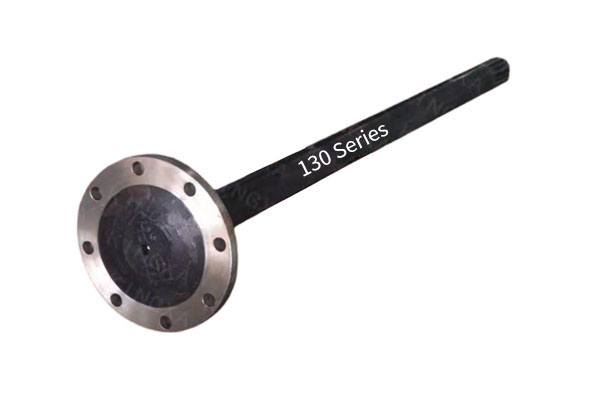How does the Heavy-Duty Vehicle Rear Axle Half Shaft ensure reliability under high loads?
Release Time : 2025-08-04
As a key component in the vehicle's drivetrain, the Heavy-Duty Vehicle Rear Axle Half Shaft's reliability under high loads is paramount. By selecting high-quality materials, optimizing design, and employing advanced manufacturing processes, the Heavy-Duty Vehicle Rear Axle Half Shaft delivers stable and reliable performance under extreme conditions, ensuring safe and efficient vehicle operation.
Material selection is fundamental to the reliability of the Heavy-Duty Vehicle Rear Axle Half Shaft. To withstand demanding operating environments, manufacturers typically choose alloy steel with excellent mechanical properties. This steel not only offers high strength and hardness, but also excellent toughness and wear resistance. These properties enable the halfshaft to effectively resist fatigue fracture and plastic deformation under continuous high-load operation, maintaining structural integrity and functional stability. Furthermore, alloy steel offers excellent corrosion resistance, ensuring long-term use without rust or damage, even in harsh environments, further extending the halfshaft's service life.
Secondly, the application of heat treatment technology plays a key role in enhancing the hardness and toughness of the Heavy-Duty Vehicle Rear Axle Half Shaft. A precisely controlled quenching and tempering heat treatment process significantly improves the internal microstructure of the steel, achieving an ideal hardness distribution. This not only enhances the wear resistance of the axle surface, but also ensures the toughness of the core, avoiding the risk of brittle fracture caused by over-hardening. Heat treatment also effectively eliminates internal stresses generated during machining, reducing the potential for crack propagation during subsequent use, and providing a stronger foundation for the axle.
Furthermore, precision manufacturing processes are crucial for ensuring the high quality of Heavy-Duty Vehicle Rear Axle Half Shafts. Modern manufacturing technologies such as CNC turning, grinding, and superfinishing are widely used in the production of axles. These high-precision machining methods ensure that every detail meets design requirements, minimize dimensional tolerances, and achieve perfect coordination with other transmission components. For example, advanced measuring equipment is used during the machining process to monitor key areas in real time, allowing timely adjustment of machining parameters to eliminate any factors that could affect the quality of the final product. Such stringent quality control measures not only improve the assembly precision of the half-shaft, but also enhance the efficiency and reliability of the entire drivetrain.
In addition to materials and manufacturing processes, design optimization is also essential to enhancing the reliability of heavy-duty vehicle rear axle half-shafts. Engineers customize the half-shaft design based on the specific vehicle application and operating conditions. For example, when facing frequent start-stop operations or heavy-load transport, the half-shaft design requires particular attention to fatigue resistance. By incorporating appropriate geometry and reinforcing ribs, the half-shaft's load-bearing capacity and impact resistance can be significantly enhanced without adding excessive weight. Furthermore, considering the varying requirements of different vehicle models, designers flexibly adjust the half-shaft's length, diameter, and connection method to ensure the optimally matched drivetrain component for each vehicle model.
In practice, heavy-duty vehicle rear axle half-shafts also require adaptability and flexibility to cope with complex and changing operating environments. Whether in rough roads or harsh climates, the half-shaft must maintain stable performance. To this end, manufacturers carefully consider various potential challenges during the design phase and implement appropriate protective measures. For example, for humid or dusty operating environments, special anti-corrosion coatings or sealing treatments can be applied to the axle surface to prevent moisture and impurities from intruding and causing damage. For high-temperature regions, high-temperature-resistant materials or improved cooling systems can be used to ensure the axle's continued functioning under extreme temperatures.
Finally, a rigorous quality inspection and verification process is the final line of defense for the reliability of the Heavy-Duty Vehicle Rear Axle Half Shaft. Each batch of products undergoes a series of rigorous tests before shipment, including but not limited to static load testing, dynamic balancing, and fatigue life testing. These tests simulate real-world operating scenarios and comprehensively assess whether the axle's performance indicators meet expected standards. Only axles that pass all tests are officially released to the market, ensuring a safe and reliable product for users.
In summary, the Heavy-Duty Vehicle Rear Axle Half Shaft achieves exceptional reliability under high-load conditions through the selection of high-quality materials, the application of advanced heat treatment technology, the implementation of precision manufacturing processes, and optimized design. It is not only a critical component for ensuring the normal operation of the vehicle but also a solid foundation for improving overall transportation efficiency and safety. With the continuous advancement and improvement of technology, I believe that Heavy-Duty Vehicle Rear Axle Half Shaft will show greater potential in more fields in the future and meet the growing market demand.
Material selection is fundamental to the reliability of the Heavy-Duty Vehicle Rear Axle Half Shaft. To withstand demanding operating environments, manufacturers typically choose alloy steel with excellent mechanical properties. This steel not only offers high strength and hardness, but also excellent toughness and wear resistance. These properties enable the halfshaft to effectively resist fatigue fracture and plastic deformation under continuous high-load operation, maintaining structural integrity and functional stability. Furthermore, alloy steel offers excellent corrosion resistance, ensuring long-term use without rust or damage, even in harsh environments, further extending the halfshaft's service life.
Secondly, the application of heat treatment technology plays a key role in enhancing the hardness and toughness of the Heavy-Duty Vehicle Rear Axle Half Shaft. A precisely controlled quenching and tempering heat treatment process significantly improves the internal microstructure of the steel, achieving an ideal hardness distribution. This not only enhances the wear resistance of the axle surface, but also ensures the toughness of the core, avoiding the risk of brittle fracture caused by over-hardening. Heat treatment also effectively eliminates internal stresses generated during machining, reducing the potential for crack propagation during subsequent use, and providing a stronger foundation for the axle.
Furthermore, precision manufacturing processes are crucial for ensuring the high quality of Heavy-Duty Vehicle Rear Axle Half Shafts. Modern manufacturing technologies such as CNC turning, grinding, and superfinishing are widely used in the production of axles. These high-precision machining methods ensure that every detail meets design requirements, minimize dimensional tolerances, and achieve perfect coordination with other transmission components. For example, advanced measuring equipment is used during the machining process to monitor key areas in real time, allowing timely adjustment of machining parameters to eliminate any factors that could affect the quality of the final product. Such stringent quality control measures not only improve the assembly precision of the half-shaft, but also enhance the efficiency and reliability of the entire drivetrain.
In addition to materials and manufacturing processes, design optimization is also essential to enhancing the reliability of heavy-duty vehicle rear axle half-shafts. Engineers customize the half-shaft design based on the specific vehicle application and operating conditions. For example, when facing frequent start-stop operations or heavy-load transport, the half-shaft design requires particular attention to fatigue resistance. By incorporating appropriate geometry and reinforcing ribs, the half-shaft's load-bearing capacity and impact resistance can be significantly enhanced without adding excessive weight. Furthermore, considering the varying requirements of different vehicle models, designers flexibly adjust the half-shaft's length, diameter, and connection method to ensure the optimally matched drivetrain component for each vehicle model.
In practice, heavy-duty vehicle rear axle half-shafts also require adaptability and flexibility to cope with complex and changing operating environments. Whether in rough roads or harsh climates, the half-shaft must maintain stable performance. To this end, manufacturers carefully consider various potential challenges during the design phase and implement appropriate protective measures. For example, for humid or dusty operating environments, special anti-corrosion coatings or sealing treatments can be applied to the axle surface to prevent moisture and impurities from intruding and causing damage. For high-temperature regions, high-temperature-resistant materials or improved cooling systems can be used to ensure the axle's continued functioning under extreme temperatures.
Finally, a rigorous quality inspection and verification process is the final line of defense for the reliability of the Heavy-Duty Vehicle Rear Axle Half Shaft. Each batch of products undergoes a series of rigorous tests before shipment, including but not limited to static load testing, dynamic balancing, and fatigue life testing. These tests simulate real-world operating scenarios and comprehensively assess whether the axle's performance indicators meet expected standards. Only axles that pass all tests are officially released to the market, ensuring a safe and reliable product for users.
In summary, the Heavy-Duty Vehicle Rear Axle Half Shaft achieves exceptional reliability under high-load conditions through the selection of high-quality materials, the application of advanced heat treatment technology, the implementation of precision manufacturing processes, and optimized design. It is not only a critical component for ensuring the normal operation of the vehicle but also a solid foundation for improving overall transportation efficiency and safety. With the continuous advancement and improvement of technology, I believe that Heavy-Duty Vehicle Rear Axle Half Shaft will show greater potential in more fields in the future and meet the growing market demand.







